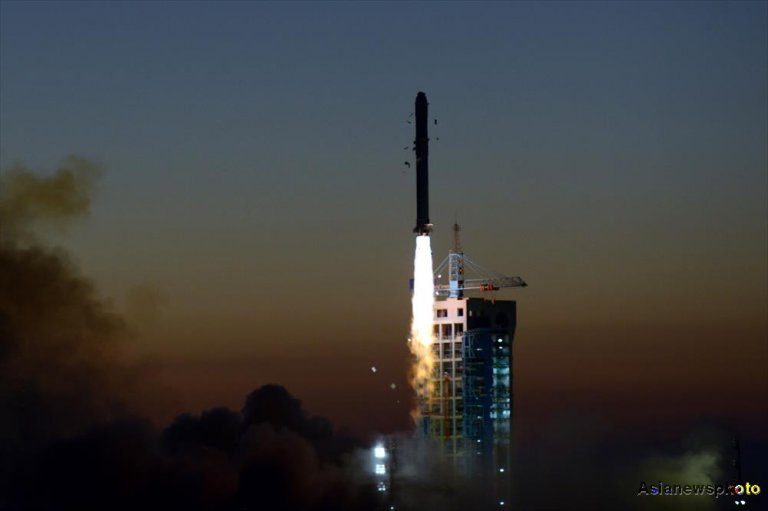

China's Wukong dark matter probe blasts off from Jiuquan Satellite Launch Centre in the Gobi Desert on December 17, 2015, opening a new era of Chinese space science. (Photo: Qu Jing Liang, China Daily)
China is pushing ahead with a range of space science missions over the coming years after setting out a long-term agenda for exploring the fundamental questions of the universe.
China is now an established major player in space, with notable human spaceflight endeavours and robotic exploration of the Moon but space science has been low on the agenda. That is changing.
Dr Wu Ji, director-general of the National Space Science Centre (NSSC) under the Chinese Academy of Sciences (CAS), has combined with colleagues across the country to provide a long-term vision for Chinese space science.
They have produced the ‘Prospect for Chinese Space Science in 2016-2030’ (Chinese) which outlines fundamental questions for study such as the formation and evolution of the universe, exoplanets and potential extra-terrestrial life, and new physics beyond the current theories.
Wu says that in the past China has made great contributions of making observations of the universe, being the first country to record sunspots, record of returns of Halley's Comet, spot supernovae and many more discoveries.
"But that was in the old days. In the modern science and technology history, China had almost nothing contribution to science and to knowledge for the human beings. China is a big country…and in GDP we are second in the world. And that's only money. So we have to make some contribution to human beings, our knowledge."
Strategic priority
China is currently in the final stages of its first batch of space science missions under CAS’s 2011 strategic priority program, implemented by the NSSC.
In December China launched its first ever dark matter probe ‘Wukong’ or ‘Monkey King’, which is now seeking hypothesised high energy signals from decayed or annihilated dark matter particles.
The existence of these particles has been inferred from their gravitational effects, but they have so far been undetectable. The probe gives China the chance to beat other countries and collaborations to making this breakthrough.
Wukong will be followed this year by three more space science missions focussing on quantum entanglement and photon ‘teleportation’, x-ray astronomy, and space life science.
2020 and beyond
But China is already looking beyond these of projects and has approved four further space science missions for development. These will enter their engineering phases over the next year, with launches scheduled for around or after 2020.
The missions are the Solar wind Magnetosphere Ionosphere Link Explorer (SMILE), a space-weather observatory mission in collaboration with the European Space Agency, the Magnetosphere, Ionosphere and Thermosphere mission (MIT) and a global water cycle observation mission, WCOM, which will address key scientific questions regarding the water cycle and global change.
The fourth, the Einstein Probe (EP), will look at large portions of the universe with a very sensitive X-ray camera and survey the skies for phenomena related to black holes, supernovae, and the electromagnetic wave counterparts of gravitational wave events – a current hot topic following the breakthrough by the LIGO experiment.
Human spaceflight, Moon and beyond
Wu’s NSSC is also involved in more immediate space projects that will make contributions to science.
The Centre is a subcontractor for payload subsystems in all the Chinese manned missions, including the Shenzhou spacecraft and Tiangong space labs.
NSSC sensors developed for the Shenzhou-11 crewed mission and Tiangong-2 space lab, which will launch later this year and dock in orbit, have been delivered, tested and are awaiting launch.
Tiangong-2 will feature an ocean topography microwave sensor that will measure the height of the oceans to an accuracy of a few centimetres and study large-scale climate change events such as el Nino.
Beyond this NSSC teams are also working on payloads for the unprecedented Chang’e-4 mission to land on the far side of the Moon in late 2018, and China’s first independent mission to Mars, which, ambitiously, is a combined orbiter, lander and rover mission and could launch in 2020.
China's space science path is expected to make due contribution to China’s economic and social development, and beyond this could produce breakthroughs for humanity at large.
"Now, we are at the beginning," says Wu. "I hope everything will continue and in the future China will have more and more science programs as one part of Chinese space activity." (GBTimes)

86-10-68597521 (day)
86-10-68597289 (night)

86-10-68511095 (day)
86-10-68512458 (night)

cas_en@cas.cn

52 Sanlihe Rd., Xicheng District,
Beijing, China (100864)

